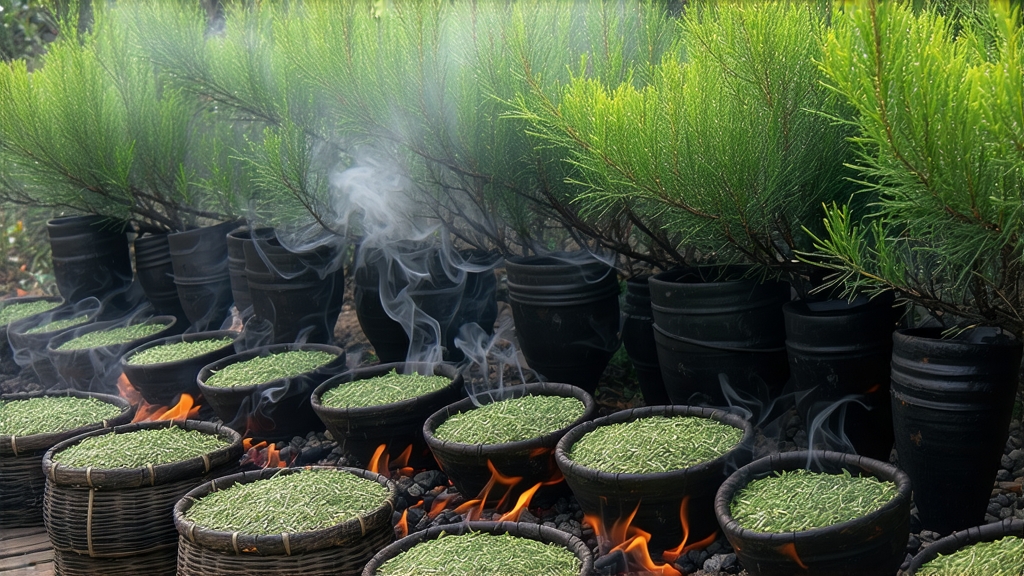
When European tea clippers first rounded the Cape of Good Hope in the late seventeenth century, the chests that fetched the highest prices at London and Amsterdam auctions were stamped with a single mysterious word: Bohea. Inside those lead-lined crates lay slender, pitch-black twists of leaf that, once steeped, exuded an intoxicating aroma of campfire and dried longan. That tea was Lapsang Souchong—today celebrated as the progenitor of every black tea on earth and still produced in the same granite gorges of Fujian’s Wuyi Mountains where its story began.
Origin & Myth
Local growers retell a Qing-dynasty legend: a passing army commandeered Tongmu village during the spring harvest. To dry the plucked leaves before they spoiled, farmers rushed them through smoking sheds heated by masson-pine fires. The accidental smoke infusion created a tea so alluring that Dutch traders paid double the usual price. Whether apocryphal or not, Dutch East India Company ledgers from 1604 list “Lapsang” (from the Fuzhou dialect la-sang, meaning “pine wood”) alongside Souchong—literally “small sort,” the fourth and most delicate leaf down the stem. Thus the name, and the global black-tea trade, was born.
Micro-Terroir
Tongmu sits in a mist-locked canyon at 27° N latitude, where the Min River cuts through a UNESCO biosphere reserve of subtropical forest and 400-million-year-old rhyolite cliffs. Day-night temperature swings of 15 °C slow leaf growth, concentrating amino acids, while the granite subsoil delivers a flinty minerality that anchors the tea’s sweet finish. Only leaves plucked within this 600-hectare core zone may bear the official designation “Zheng Shan Xiao Zhong,” the protected geographical indication that separates authentic Lapsang from distant imitations.
Leaf Hierarchy
Connoisseurs recognize three ascending grades. Leaf-grade Lapsang uses the standard two-leaf-and-a-bud pick, giving a brisk, copper-liquored cup. Broken-grade, produced during the mid-season, offers stronger malt notes for Russian-style samovars. Supreme-grade Tongmu Jinjun Mei, invented in 2005, restricts plucking to single buds harvested before Qingming festival, yielding downy golden tips and a honeyed complexity that fetches over US $1,000 per 100 g at auction. Each tier is still withered, rolled, oxidized and smoked within a five-kilometre radius of the original village.
Craft: Smoke as Signature
The process begins at dusk. Fresh leaves are spread on bamboo trays above ground-level trenches where pine logs smolder at 40 °C for eight hours, a gentle withering that removes 60 % moisture while impregnating the leaf with resinous volatiles—guaiacol, syringol, creosol—molecules later amplified during oxidation. Rolling follows, a 45-minute rhythmic kneading that ruptures cell walls and initiates enzymatic browning. Oxidation proceeds in cedar-lined chests at 24 °C and 85 % humidity; master sniffers plunge bare forearms into the leaf every twenty minutes, judging readiness by the moment peach skin and cacao notes eclipse raw grass. Final smoking, the “pine finish,” lasts only three minutes over embers of 60-year-old masson heartwood whose resin has crystallized into amber. Too long and the tea tastes medicinal; too short and the signature whisper of campfire is lost.
Chemical Signature
Gas-chromatography studies at Fujian Agriculture University identify 42 aromatic compounds unique to Tongmu Lapsang. The ratio of syringol to guaiacol—ideally 2.3:1—acts as a chemical fingerprint, distinguishing authentic pine-smoke from cheaper liquid smoke flavoring. Meanwhile, theaflavin levels hover at 1.8 %, lower than Assam but twice that of green tea, delivering brisk astringency without bitterness when brewed correctly.
Brewing: Gongfu vs. Western
For gongfu service, use 5 g of leaf in a 120 ml porcelain gaiwan. Rinse once with 95 °C water to awaken the leaf, then steep 5 s, 7 s, 10 s, adding two seconds each infusion. The first cup opens with pine and dried apricot; the third reveals cocoa and a cooling cam